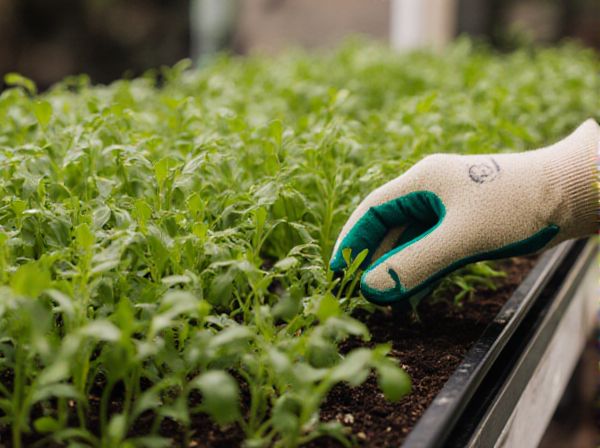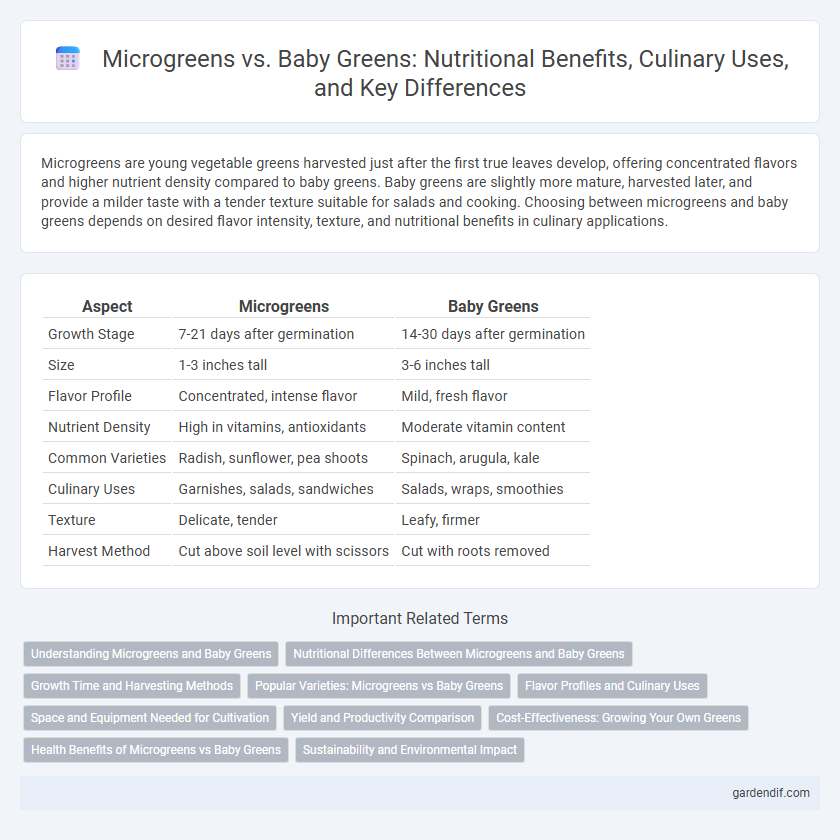
Microgreens vs Baby greens Illustration
Microgreens are young vegetable greens harvested just after the first true leaves develop, offering concentrated flavors and higher nutrient density compared to baby greens. Baby greens are slightly more mature, harvested later, and provide a milder taste with a tender texture suitable for salads and cooking. Choosing between microgreens and baby greens depends on desired flavor intensity, texture, and nutritional benefits in culinary applications.
Table of Comparison
| Aspect | Microgreens | Baby Greens |
|---|---|---|
| Growth Stage | 7-21 days after germination | 14-30 days after germination |
| Size | 1-3 inches tall | 3-6 inches tall |
| Flavor Profile | Concentrated, intense flavor | Mild, fresh flavor |
| Nutrient Density | High in vitamins, antioxidants | Moderate vitamin content |
| Common Varieties | Radish, sunflower, pea shoots | Spinach, arugula, kale |
| Culinary Uses | Garnishes, salads, sandwiches | Salads, wraps, smoothies |
| Texture | Delicate, tender | Leafy, firmer |
| Harvest Method | Cut above soil level with scissors | Cut with roots removed |
Understanding Microgreens and Baby Greens
Microgreens are young seedlings of edible vegetables and herbs harvested just after the first true leaves develop, typically within 7 to 21 days, known for their intense flavors and concentrated nutrient content. Baby greens refer to slightly more mature leafy greens harvested between 14 to 30 days, offering a milder taste and larger leaf size compared to microgreens. Understanding these differences highlights microgreens' use in garnishes and nutrient boosts, while baby greens are favored for salads and cooking due to their texture and volume.
Nutritional Differences Between Microgreens and Baby Greens
Microgreens contain higher concentrations of vitamins, minerals, and antioxidants compared to baby greens, with studies showing vitamin C, E, and K levels up to 40 times greater per weight. Baby greens offer a more substantial volume and fiber content due to their larger size and longer growth period, contributing to digestive health. Both microgreens and baby greens provide unique nutritional benefits, with microgreens excelling in nutrient density and baby greens contributing more dietary fiber.
Growth Time and Harvesting Methods
Microgreens typically require 7 to 21 days to grow before harvesting, allowing for quick, multiple crop cycles in limited space. Baby greens take longer, about 21 to 30 days, offering larger leaves and more developed flavors suitable for salads and garnishes. Microgreens are harvested by cutting just above the soil line, while baby greens are usually cut at the base, preserving entire plants for freshness and extended shelf life.
Popular Varieties: Microgreens vs Baby Greens
Microgreens popular varieties include radish, sunflower, pea shoots, and basil, known for their intense flavors and high nutrient density. Baby greens varieties such as spinach, arugula, kale, and lettuce offer tender texture and mild taste, ideal for salads and sandwiches. Both microgreens and baby greens provide diverse culinary uses, with microgreens often used as garnishes and baby greens serving as base greens in dishes.
Flavor Profiles and Culinary Uses
Microgreens offer intense, concentrated flavors ranging from peppery arugula to sweet basil, making them ideal for garnishing salads, sandwiches, and gourmet dishes. Baby greens have milder, more delicate tastes like tender spinach or butter lettuce, commonly used as a base in salads or sauteed for gentle flavor enhancement. Both microgreens and baby greens boost nutritional value and visual appeal, but chefs select microgreens for punchy notes and baby greens for subtle, versatile textures.
Space and Equipment Needed for Cultivation
Microgreens require significantly less space and minimal equipment, typically growing in shallow trays under controlled light conditions, making them ideal for urban or indoor cultivation. Baby greens need more space for proper root expansion and often require deeper containers or garden beds, along with natural sunlight or grow lights to thrive. Efficient use of vertical farming techniques can optimize space for both, but microgreens generally offer a faster, more compact growing cycle.
Yield and Productivity Comparison
Microgreens offer higher yield per square foot due to their short growth cycle of 7-21 days, allowing multiple harvests annually compared to baby greens which require 21-40 days. Productivity is enhanced in microgreens with dense planting and faster turnover rates, making them ideal for urban farming and controlled environments. Baby greens provide larger leaves and longer shelf life, but yield fewer harvests over the same period, impacting total productivity.
Cost-Effectiveness: Growing Your Own Greens
Growing microgreens at home offers a more cost-effective solution compared to baby greens, as microgreens require less time and fewer resources to cultivate, typically maturing within 7-14 days. Baby greens demand longer growth periods and more space, increasing water and nutrient costs, which impacts overall expense. Homegrown microgreens deliver fresh, nutrient-dense greens with minimal investment, making them ideal for budget-conscious gardeners seeking maximum yield and value.
Health Benefits of Microgreens vs Baby Greens
Microgreens contain higher concentrations of vitamins C, E, and K compared to baby greens, boosting antioxidant intake and immune support. Their dense nutrient profile includes elevated levels of polyphenols and carotenoids, which contribute to improved heart health and reduced inflammation. Consuming microgreens can offer more potent health benefits per serving than baby greens, making them a superior choice for nutrient-rich diets.
Sustainability and Environmental Impact
Microgreens require significantly less water and space compared to baby greens, making them a more sustainable choice for urban farming and reducing environmental footprints. Their shorter growth cycles, often harvested within 10-14 days, contribute to lower energy usage and decreased carbon emissions during production. Cultivating microgreens also minimizes soil degradation and reduces the need for synthetic fertilizers, enhancing overall eco-friendliness in edible crop production.
Microgreens vs Baby greens Infographic

 gardendif.com
gardendif.com